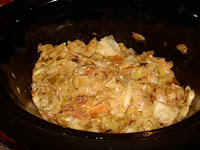
I've always loved to cook. I find myself at home in the kitchen, but being a newlywed (another excuse to post a wedding pic!) with a well-stocked
army of cookware has brought this whole domestic thing to another level.
Before I moved to Italy, I used to enjoy making a weekly menu with inspiration from my 5 food magazine subscriptions. (I pared them down to two--Fine Cooking and Cook's Illustrated.) I would plan the meals, usually 3, make a list, and go to the grocery store Sunday afternoons. It worked well, as I only really needed one other trip mid-week to replenish
milk/wine supply. I saved money and had everything I needed when I got home from slaving over a hot 5th grade classroom all day.
The 3 meals with subsequent leftovers stretched the whole week and provided for a couple of lunches--to break the sandwich monotony.
Once living in Italy, starting in June 2003, I would make daily trips to the vegetable stand, bakery, and salumeria. Everything was incredibly fresh and bread went stale wonderfully quickly so it was the custom there to 'do the shopping' every morning.
Coming home after 4 and a half years presented some challenges with a hint of culture shock, so some adjustment was necessary. I've spent the last year and a half with my now husband shopping and meal-planning all willy-nilly. Dinner is decided sometime during the course of the day, with an after-work trip to the store for one meal resulting in a $50 hemorrhage.
Now that we're married, live under one roof, and have a much less chaotic existence, I decided it was time to get back to having a practical kitchen--well-planned, functional, and economic.
Here's where the Crock-Pot comes in. I thought it would be fun to have one week revolve around this timeless appliance, and really see what it was made of. Best of all, every evening, returning from a long work day just before 7, I had very little prep and dinner was on the table by 7:30.
Here's how it went...
Sunday, stock the pantry, make the Pork Chops:
You might have seen my last post about the pork chops (along with the in-serious-need-of-a-good-food-stylist pic) which were Sunday night's meal (no left-overs). It was perfect for a weekend day because it required a bit more pre-Crock cooking. No hurry, lazy Sunday indulgence with a hint of Law and Order.
Monday: Spicy Chicken Stew
I snagged this recipe from MyRecipes.com...
click here to see it. This was a throw-everything-in-the-pot-and-close-the-lid type of dish. Satisfying, delicious, and healthy, it filled the house with a warm glow. It was very inexpensive too because I used a pack of chicken thighs. Being slow-braised for so long, the dark-meat-phobic wouldn't even tell the diff. After work, all I did was shred the chicken right in pot, chop some cilantro, and away we ate.
Tuesday: Spicy Chicken Stew ReduxComing home close to 7, I took the stew from the fridge, added a little more broth into the saucepan and reheated. I washed and spun the head of lettuce from Sunday shopping, dressed half and left the other in the spinner. (The salad spinner, by the way, is a great storage environment for already cut and washed lettuce. It does take up a some room in the fridge but in mine, it's worth every bit of this valuable real-estate. Even delicate lettuce will stay fresh for right around 4 days. All that's left to do is dress--great time-saver.) Before bed, I put a pound of white beans to soak for the next morning.
Wednesday: Beans!

I love white beans and dark greens.** I could eat my weight in them. Whether it's chicory (only Italy, definitely can't find chicory in Texas), scarola (escarole), or kale, I'm all over it. It's so healthy and feels quite indulgent. I used the method found in
Michele Scicolone's awesome cookbook,
The Italian Slow Cooker. Just cover soaked beans in abundant water, add a bay-leaf, and cook on low for 6-7 hours. This took me 5 minutes in the morning before heading out the door. When I came home, I washed the escarole and sauteed it with some whole cloves of garlic while warming the beans in chicken broth. I only used a little bit of the cooking liquid because it was unsalted. These beans are a blank canvas and can be sassed up at will. When the escarole was cooked, I added it to beans and plated with a grinding of pepper and a drizzle of olive oil. Again, I dressed the salad, set the table and we sat down to veggie nirvana. This dish is the ultimate comfort food and you will never know that it's so healthy.
Thursday: Beans and Escarole EncoreYou get the routine by now, right? I reheated the beans with little broth like before. This time unfortunately, I totally pigged out on the escarole the night before so there was just a tiny bit left. I mixed in what was left, sliced up a few carrots to add to the last bit of lettuce, dressed and dinner was served.
I have to tell you that I thought I knew a creamy bean from a mealy one, but apparently I was wrong. These beans had the silkiest texture that I have ever experienced. All of that long, slow cooking really makes the difference. I was shopping at the regular grocery store where they didn't have cannellini beans (?), so I bought regular old white ones with no resulting complaints from the happy hubby department. (Not that he
ever complains!)
There you have it, one very long post. My
DoBianchi's been traveling so much and working so hard that our little routine has been knocked a bit off-kilter. But we'll get it back, he'll be home with me, and it will be delicious.
**A note on the greens: You might have a hard time finding escarole if you live outside of an urban area, so I would use kale. I don't love the super curly kind, I find it kind of bland. My favorite is the 'Lacinto Kale' with its long, black-green leaves. I make it like I make all other leafy greens, with a generous pour of olive oil heated in a pan with a couple of whole cloves of garlic. Tilt the pan so the cloves are bathing and bubbling in the oil. Throw the greens into the hot pan and quickly cover (it will hiss and spit, but it makes it taste better). Let this drama go on for a couple of minutes , stir and salt, and let the greens cook on medium-low until they're done. This takes a little longer with kale, a little less with broccoli rabe. Escarole takes a while to expel all of its water, but give it it's time, the flavor concentrates if you wilt it down right.





































